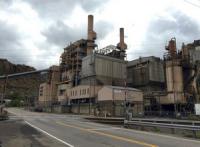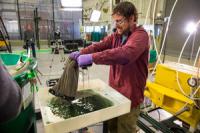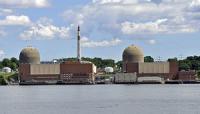-
Wastewater injection rates triggered Oklahoma's largest earthquake
The 3 September 2016 magnitude 5.8 Pawnee quake, felt widely across Oklahoma, is the largest earthquake recorded in the state since the 1950s. Most Oklahoma earthquakes since 2009 are thought to have been triggered by wastewater produced by oil and gas drilling that has been injected back into the ground – and a new report says that changes to the rate of wastewater injection in disposal wells may have contributed to conditions that led to the Pawnee earthquake.
-
-
BP oil spill did $17.2 billion in damage to natural resources

The 2010 BP Deepwater Horizon oil spill did $17.2 billion in damage to the natural resources in the Gulf of Mexico, a team of scientists recently found after a six-year study of the impact of the largest oil spill in U.S. history. This is the first comprehensive appraisal of the financial value of the natural resources damaged by the 134-million-gallon spill.
-
-
Clean power planning

With a single executive order issued at the end of March, the Trump administration launched a robust effort to roll back Obama-era climate policies designed to reduce U.S. carbon dioxide (CO2) emissions. Chief among those policies is the Clean Power Plan, which targets coal and natural gas-fired electric power plants that account for about 40 percent of the nation’s CO2 emissions. Private and public-sector investors may see the executive order as a green light to double down on relatively cheap fossil fuels and reduce holdings in more costly, climate-friendly, non-carbon generation technologies such as wind, solar and nuclear. But they may want to think twice before making such transactions – and a new study details why it’s prudent to invest in carbon-free electricity now.
-
-
Sustainability’s threat to fossil fuel industry is only going to increase
Commercial activity in fossil fuels is increasingly at odds with global actions to reduce the threat of climate change. Burning coal, oil, and natural gas is responsible for two-thirds of humanity’s emissions of greenhouse gases, and yet provides more than 20 percent of GDP in two dozen nation states. By Citicorp’s estimate, current commitments to reduce these emissions could mean forgoing $100 trillion in fossil fuel revenues by 2050 — representing a huge disruption to global affairs, undermining national budgets and corporate balance sheets while exposing stakeholders, including pension holders and ordinary citizens in resource-exporting states, to myriad risks.
-
-
Carbon Law, modeled after Moore’s Law, a pathway to halve emissions every decade

Moore’s Law states that computer processors double in power about every two years. While it is neither a natural nor legal law, this simple rule of thumb or heuristic has been described as a golden rule which has held for fifty years and still drives disruptive innovation. Research say that a carbon roadmap, driven by a simple rule of thumb, or Carbon Law, of halving emissions every decade, could catalyze disruptive innovation. Following a Carbon Law, which is based on published energy scenarios, would give the world a 75 percent chance of keeping Earth below 2°C above pre-industrial temperatures, the target agreed by nations in Paris in 2015.
-
-
Reusable sponge could revolutionize oil spill and diesel cleanup

When the Deepwater Horizon drilling pipe blew out seven years ago, beginning the worst oil spill in U.S. history, those in charge of the recovery discovered a new wrinkle: the millions of gallons of oil bubbling from the sea floor weren’t all collecting on the surface where it could be skimmed or burned. Some of it was forming a plume and drifting through the ocean under the surface. Now, scientists have invented a new foam, called Oleo Sponge, that addresses this problem.
-
-
Coal and oil demand to peak by 2020: Report
A boom in the popularity of solar panels and electric cars could spark irreversible changes in the energy sector within three years. By 2020, the global demand for coal and oil could peak and start to decline, according to a new report. The power and road transport sectors account for approximately half of fossil fuel consumption, so growth in the solar panel and electric vehicle markets can have a major impact on demand. The findings of this report could have serious implications for businesses and governments that supply these fossil fuels.
-
-
Electricity costs to surge in a warming world
Climate change is likely to increase U.S. electricity costs over the next century by billions of dollars more than economists previously forecast, according to a new study. The study shows how higher temperatures will raise not just the average annual electricity demand, but more importantly, the peak demand. And to avoid brownouts and absorb these surges, utilities will need to spend between $70 billion and $180 billion in grid upgrades—power plants and futuristic energy storage systems for which ratepayers would ultimately foot the bill.
-
-
Earthquakes triggered by humans pose growing risk
People knew we could induce earthquakes before we knew what they were. As soon as people started to dig minerals out of the ground, rockfalls, and tunnel collapses must have become recognized hazards. Today, earthquakes caused by humans occur on a much greater scale. Events over the last century have shown mining is just one of many industrial activities that can induce earthquakes large enough to cause significant damage and death. Filling of water reservoirs behind dams, extraction of oil and gas, and geothermal energy production are just a few of the modern industrial activities shown to induce earthquakes. The only evidence-based way to limit the size of potential earthquakes may be to limit the scale of the projects themselves. In practice, this would mean smaller mines and reservoirs, less minerals, oil and gas extracted from fields, shallower boreholes and smaller volumes injected. A balance must be struck between the growing need for energy and resources and the level of risk that is acceptable in every individual project.
-
-
NY’s Indian Point nuclear plant to close after many “safety events”

New York’s Indian Point nuclear power plant will close by April 2021, Governor Andrew Cuomo said on Monday. “For fifteen years, I have been deeply concerned by the continuing safety violations at Indian Point, especially given its location in the largest and most densely populated metropolitan region in the country,” Cuomo said. “I am proud to have secured this agreement with Entergy [the plant’s operator] to responsibly close the facility fourteen years ahead of schedule, to protect the safety of all New Yorkers.”
-
-
Future of nuclear energy unclear
Despite a turbulent history, the allure of nuclear energy — electricity production on a massive scale with minimal emissions — remains attractive. Its low emission rate is why the United Nations International Panel on Climate Change recommends doubling the world’s nuclear capacity by 2050. Yet the bulk of the 100 nuclear reactors currently operating in the U.S., which continue to produce about 20 percent of the nation’s energy, are reaching retirement age, and energy market forces don’t always favor nuclear.
-
-
Mystery of historic 1952 London killer fog, current Chinese haze solved
Few Americans may be aware of it, but in early December 1952 a killer fog that contained pollutants covered London for five days, causing breathing problems and killing more than 12,000 people of all ages, sending more than 150,000 to hospitals, and killing thousands of animals in the area. It is still considered the worst air pollution event in the European history. The exact chemical processes that led to the deadly mix of fog and pollution have not been fully understood over the past sixty years – until now. Scientists have now established that coal burning was the main culprit: sulfuric acid particles were formed from sulfur dioxide released by coal burning, and this process was facilitated by nitrogen dioxide, another co-product of coal burning. The study shows that similar chemistry occurs frequently in China, which has battled air pollution for decades.
-
-
Meeting global energy demands with nuclear power
An international team of scientists suggests that we must ramp up energy production by nuclear power if we are to succeed in warding off the worst effects of greenhouse gas emissions on climate change. The team suggests that beginning in 2020 we could achieve an annual electricity output of 20 terawatts without needing to develop carbon dioxide trapping and storage technology for the tens of billions of tons of emissions that would otherwise drive global warming to catastrophic levels.
-
-
Some early 20th century L.A. earthquakes might have been man-made
Some early twentieth century earthquakes in southern California might have been induced (man-made) by past practices that were used by the oil and gas industry. During the early decades of the oil boom, withdrawal of oil was not balanced by injection of fluids, in some cases leading to dramatic ground subsidence, and potentially perturbing the sub-surface stress field on nearby faults.
-
-
Wastewater disposal induced 2016 Magnitude 5.1 Oklahoma earthquake
Distant wastewater disposal wells likely induced the third largest earthquake in recent Oklahoma record, the 13 February 2016, magnitude 5.1 event roughly thirty-two kilometers northwest of Fairview, Oklahoma. at the time, the Fairview earthquake was the largest event in the central and eastern United States since a 2011 magnitude 5.7 struck Prague, Oklahoma.
-
More headlines
The long view
Trump Is Fast-Tracking New Coal Mines — Even When They Don’t Make Economic Sense
In Appalachian Tennessee, mines shut down and couldn’t pay their debts. Now a new one is opening under the guise of an “energy emergency.”
Smaller Nuclear Reactors Spark Renewed Interest in a Once-Shunned Energy Source
In the past two years, half the states have taken action to promote nuclear power, from creating nuclear task forces to integrating nuclear into long-term energy plans.
